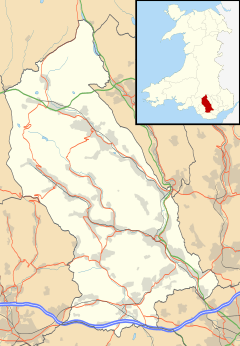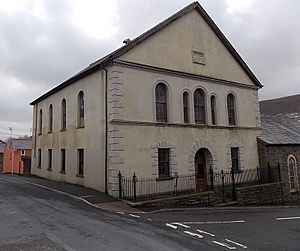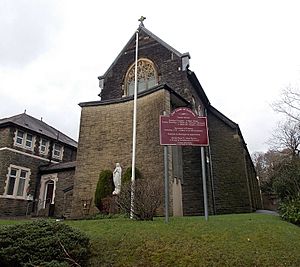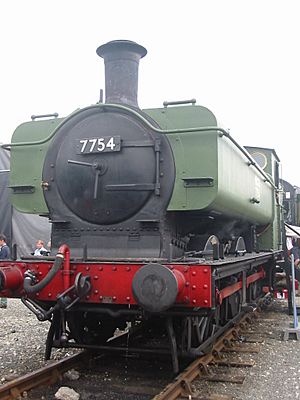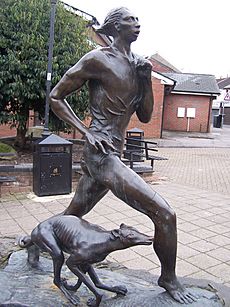Mountain Ash, Rhondda Cynon Taf facts for kids
Quick facts for kids Mountain Ash
|
|
|---|---|
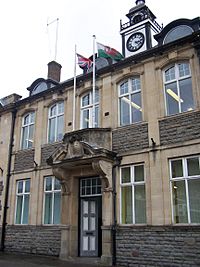 Mountain Ash Town Hall |
|
| Population | 11,230 (2011) |
| OS grid reference | ST025915 |
| Community |
|
| Principal area |
|
| Ceremonial county | |
| Country | Wales |
| Sovereign state | United Kingdom |
| Post town | MOUNTAIN ASH |
| Postcode district | CF45 |
| Dialling code | 01443 |
| Police | South Wales |
| Fire | South Wales |
| Ambulance | Welsh |
| EU Parliament | Wales |
| UK Parliament |
|
| Welsh Assembly |
|
Mountain Ash (Welsh: Aberpennar) is a town in the Cynon Valley in Wales. It is part of the Rhondda Cynon Taf area. In 2011, about 11,230 people lived there.
The town includes several small areas. These are Cefnpennar, Cwmpennar, Caegarw, Darranlas, Fernhill, Glenboi, and Newtown. Mountain Ash is about 7.2 km (4.5 miles) south-east of Aberdare. It is also about 31 km (19 miles) south-east of Cardiff.
Contents
The Name of Mountain Ash
Before the town grew, the area had different Welsh names. One old name was Aberpennar. This means "Mouth of the river Pennar". It was first written down in 1570. Another name used was Dyffryn, which means "Valley".
The English name, Mountain Ash, comes from an old pub. This pub was called the Mountain Ash Inn. It opened around 1809 on the old Aberdare Road. The story says that the owner, John Bruce Pryce, asked David John Rhys what to name the new pub. Rhys saw a lone "Cerdinen" nearby. This is the Welsh name for a Rowan or mountain ash tree. So, Rhys suggested calling it "Mountain Ash".
This Inn became a well-known place for travelers. By the 1830s, the name Mountain Ash was used for the growing industrial village. Even though "Aberpennar" and "Dyffryn" were still used for some places, Mountain Ash became the main name.
In 1905, a big Welsh festival called the National Eisteddfod was held in the town. A poet named Watkin Wyn wrote a poem. He asked people to use the old Welsh name, Aberpennar, instead of Mountain Ash. Because the festival was so popular, many Welsh-speaking people in the town started using Aberpennar. It soon became the official Welsh name for the town.
Town History
Mountain Ash, like other places in the Cynon Valley, had many Welsh speakers for a long time. The town started to grow after the Aberdare Canal was built in 1818. This canal was later filled in to make a road in 1933.
The number of people living in Mountain Ash grew a lot. In 1841, there were 1,614 people. By 1871, this number jumped to 11,463. This was because many coal mines opened nearby. By 1859, the town had 12 pubs.
After the First World War, the coal industry started to slow down. After the Second World War, new factories were built. This helped create jobs as the mines closed. By the end of the 1900s, most mines and many factories had shut down. New, smaller industries and service jobs helped the town's economy.
Places of Worship
Mountain Ash used to have many nonconformist chapels. These were churches not part of the main Church of England. Today, only one Welsh-language chapel remains. It is called Bethania (Independent). Other chapels, like Bethlehem and Bethel, have closed.
The town was also part of the 1904–1905 Welsh Revival. This was a time when many people became very religious. One evening, a large group marched through the streets. They then went to a meeting at Bethania Chapel.
How Mountain Ash is Governed
Mountain Ash is part of the Rhondda Cynon Taf County Borough Council. This council helps run the town. Since 2022, the town has an electoral ward called Mountain Ash. This ward elects two councillors to the council.
In the past, Mountain Ash was part of different parishes. In 1863, its own church parish was created. A local government group was set up in 1867 to manage the growing town. This group was called the Mountain Ash Local Board.
Later, in 1894, this board became the Mountain Ash Urban District Council. This council built the Mountain Ash Town Hall. It was finished in 1904 and used for offices and meetings.
In 1974, the Mountain Ash Urban District was ended. The area became part of the Cynon Valley borough. Later, in 1982, Mountain Ash was divided into smaller communities. In 2017, the Mountain Ash community was split into Mountain Ash East and Mountain Ash West. These communities do not have their own councils.
Since 1996, Rhondda Cynon Taf County Borough Council has been in charge of Mountain Ash.
Getting Around Town
The town has a train station called Mountain Ash railway station. It is on the line that goes to Aberdare. The nearby villages of Fernhill and Penrhiwceiber also have stops on this line. Bus services in the area are run by Stagecoach in South Wales.
NCB Mountain Ash Railway
An old railway line developed in the South Wales Valleys. It was called the Mountain Ash Railway (MAR). This railway started as a tramway. In the 1970s, it became the last railway in the UK to use steam trains.
The railway was built by a company called Powell Duffryn. It connected different industrial sites. The main part of the railway was around Mountain Ash. It ran from the Penrikyber Colliery, past coal storage areas, and through the Nixon's Navigation colliery. This colliery had the railway's workshops and train sheds. The line ended at the Abercwmboi Phurnacite plant.
The railway connected to the main UK rail network at the Mountain Ash (Cardiff Road) railway station. It also had access to another railway line.
Many different types of steam locomotives were used on the MAR. After World War Two, most trains were Hunslet Austerity 0-6-0STs. In 1959, the National Coal Board (NCB) bought an old GWR Pannier Tank train, No. 7754. This train was a bit heavy for the MAR's tracks. But it became a favorite with the railway workers.
This train, No. 7754, became the last British-built steam locomotive to operate in the UK. It stopped running in 1975 because of a crack in its engine. The NCB gave the train to the National Museum Wales. It is now on loan to the Llangollen Railway. The Mountain Ash Railway closed in the mid-1980s after a big miners' strike.
Learning and Schools
Mountain Ash Comprehensive School is for students aged 11 to 18. It is built on the land that used to belong to Lord Aberdare. The main house, Dyffryn House, was used by the school until it was taken down in the 1990s.
Across from the school is a hospital called Ysbyty Cwm Cynon. It opened in 2012 and replaced the old Mountain Ash General Hospital.
There are several primary schools in the area. These include Our Lady's RC Primary School, Caegarw Primary School, Glenboi Primary School, Darranlas Primary School, Miskin Primary School, Pengeulan Primary School, and Penrhiwceiber Primary School.
Sports and Fun Activities
Mountain Ash has a rugby union team called Mountain Ash RFC. The Rugby league club South Wales Scorpions also played their home games here in 2014-2015.
The Nos Galan road race is a famous event held every year. It is a 5 km (3.1 miles) running race. It happens on New Year's Eve (Nos Galan). The race celebrates Guto Nyth Bran, a legendary Welsh runner. It started in 1958. Now, over 800 runners take part, and 10,000 people come to watch the race and enjoy the street entertainment.
The town also had a football club called Tynte Rovers, but it closed in 2019.
In 1974, the Mountain Ash RFC Singers, a male-voice choir, was formed by former rugby players. Mountain Ash hosted the National Eisteddfod in 1905 and again in 1946.
The town of Mountain Ash inspired the fictional town of Aberowen in the book Fall of Giants by Ken Follett. The town also appears in Danny Wallace's 2005 book Yes Man.
Famous People from Mountain Ash
- Mark Brake (born 1958), an author and science communicator.
- Guto Nyth Brân (1700–1737), a legendary Welsh athlete. He was once known as the fastest man on Earth.
- Howard Collins (born 1949), a karate instructor.
- Pennar Davies (1911–1996), a minister and author.
- Brian Juliff (born 1952), a rugby player who played both rugby union and rugby league.
- Stuart Manley (born 1979), a professional golfer.
- Elaine Morgan (1920–2013), a BAFTA award-winning author.
- Haydn Morris (born 1928), an international rugby union player.
- Harri Webb (1920–1994), a poet and librarian.
- Richard "Dickie" Williams (1925–1997), a rugby league player.
- Duane Jones (snooker player), a professional snooker player.
Location grid
 |
Aberdare
^ Cefnpennar, Cwmpennar, Fernhill & Glenboi |
 |
||
| Darranlas | Caegarw & Newtown | |||
| Miskin
v Penrhiwceiber |
See also
 In Spanish: Mountain Ash para niños
In Spanish: Mountain Ash para niños


